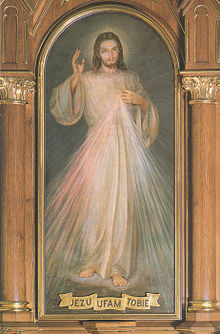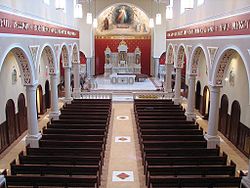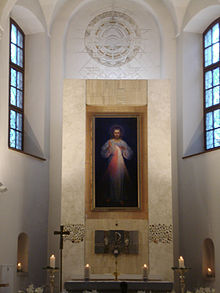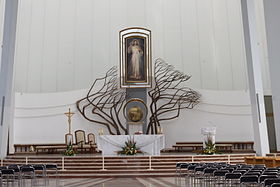- Divine Mercy image
-
The Divine Mercy image is a depiction of Jesus based on the devotion initiated by Saint Faustina Kowalska.
The image has been depicted by a number of artists and it show Jesus raising his right hand in a gesture of blessing and pointing with his left hand on his chest from which flow forth two rays: one red and one white (translucent). The depictions often contains the message "Jesus, I trust in You!" (Polish: Jezu ufam Tobie). The rays streaming out have symbolic meaning: red for the blood of Jesus (which is the life of souls) and pale for the water (which justify souls) (from Diary - 299). The whole image is symbolic of charity, forgiveness and love of God, referred to as the "fountain of mercy".
The image is, according to the Diary of Sister Faustina, based on a vision of Jesus in 1931.[1] Faustina wrote that, in the vision, Jesus instructed her to "Paint an image according to the pattern you see, with the signature: Jesus, I trust in You. I desire that this image be venerated, first in your chapel, and then throughout the world."[2]
A number of artistic renditions of the image have appeared since Faustina directed the painting of the first image in Lithuania. The image is widely venerated by Catholics worldwide and is used in the celebration of Divine Mercy Sunday.
Contents
Context and background
History and origin
Faustina Kowalska was a Polish nun who joined the convent of Our Lady of Mercy in Warsaw 1925.[3][4] In her diary, which was later published as the book Diary: Divine Mercy in My Soul, Faustina wrote about a number of visions of Jesus and conversations with him.[3] Her confessor was Michael Sopocko, a priest and a professor of theology.[3][4]
A 2006 rendition of the image above the altar of the sanctuary of the Fathers of Mercy
In 1930, Faustina was assigned to the convent in Plock, Poland. Faustina stated that on the night of Sunday February 22, 1931, while she was in her cell in Plock, Jesus appeared to her as the "King of Divine Mercy" wearing a white garment.[5][6] Faustina wrote that Jesus' right hand was raised in a sign of blessing and the other was touching the garment near his breast, and that from beneath the garment slightly down, aside his breast, emanated two large rays, one red, the other white.[5][6][7] Another nun, sister Christine, later stated that rays of light from the window were visible that night and attracted the attention of people standing on the other side of the street, implying that this was a "physical" appearance rather than an interior vision.[5][8]
In her diary (Notebook 1, items 47 and 48) she wrote that Jesus told her:[3]
Paint an image according to the pattern you see, with the signature: "Jesus, I trust in You". I desire that this image be venerated, first in your chapel, and then throughout the world. I promise that the soul that will venerate this image will not perish.[3][5]
Not knowing how to paint, Faustina approached some other nuns at the convent in Pluck for help, but received no assistance. She attempted to sketch the image with charcoal on canvas, but had little success.[4][9] In her diary (Notebook 1, item 53) she wrote that Jesus told her that she would receive "visible help" with the task. In November 1932 Faustina left Pluck and went back to Warsaw and in May 1933 she was sent to the convent in Vilnius, as the gardener.[10]
In Vilnius Faustina met Father Michael Sopocko, the newly appointed confessor to the nuns.[10] Sopocko supported Faustina's efforts and arranged for the first painting of the image by the artist Eugene Kazimierowski.[4][5][10] Faustina saw only the first painting.[5] After Faustina's death, a number of other artists painted the image, with the depiction by Adolf Hyla being among the most reproduced.[11]
Devotional significance
.
“ Not in the beauty of the color, nor of the brush lies the greatness of this image, but in My grace. — Words attributed to Jesus by Faustina in her diary.[10][12][13] ” After the canonization of Faustina in April 2000 the devotion to Divine Mercy and the image has been followed by Catholics.[14][15] The devotional following of the image and Faustina's message has been stronger among Catholics at large than among theologians.[16] Author Benedict Groeschel considers a modest estimate of the following in 2010 to be over one hundred million Catholics.[16]
Faustina's diary relates the rays of light within the image to life and salvation, stating (Notebook 1, item 299) that she was told by Jesus: "The two rays denote Blood and Water. The pale ray stands for the Water which makes souls righteous. The red ray stands for the Blood which is the life of souls... These two rays issued forth from the very depths of My tender mercy when My agonized Heart was opened by a lance on the Cross."[17][18]
In her diary, Faustina wrote that Jesus emphasized the importance of the image as part of the Divine Mercy devotion and in Notebook 1, item 327 attributed these words to Jesus: "I am offering people a vessel with which they are to keep coming for graces to the fountain of mercy. That vessel is this image with the signature; 'Jesus, I trust in You.'"[19] Catholic devotions thus stress the importance of the image as a "conduit for grace" as part of the Divine Mercy message.[13]
Faustina's diary also relates the image to Divine Mercy Sunday. Faustina wrote (Notebook 1, item 49) that Jesus told her that he wanted the Divine Mercy image to be "solemnly blessed" on the first Sunday after Easter; and that Sunday was to be the Feast of Mercy.[3][20]
Pope John Paul II instituted Divine Mercy Sunday (Dominica II Paschae seu de divina misericordia) and placed it on the General Roman Calendar.[21] The Divine Mercy image is often carried in processions on Divine Mercy Sunday, and is placed in a location in the church so that it can be venerated by those who attended the Mass.[14]
The veneration of the Divine Mercy image also takes place in conjunction with the Divine Mercy Chaplet and Novena.[3][22] The Vatican biography of Faustina states that the veneration of the Divine Mercy image is part of the second component of her message, namely "entreating God's mercy for the whole world".[23] Praying before the Divine Mercy image (with the signature "Jesus I trust in you") is not only encouraged in Catholic devotions, but is mentioned as a partial condition for some of the indulgences associated with Divine Mercy Sunday.[24]
Artistic renditions
The first painting
The first Divine Mercy painting by Kazimierowski (1934) at the Divine Mercy Sanctuary (Vilnius)
The first painting was painted by Eugene Kazimierowski, under the supervision of Faustina and her confessor, Michael Sopocko, in Vilnius in 1934.
Sopocko was a professor of theology at the University of Vilnius and introduced Faustina to Kazimirowski who was a professor of art there. Kazimirowski had painted religious images before, but this task was difficult for him. Father Sopocko posed himself as Jesus for the image, wearing an alb, and both he and Faustina regularly visited the painter‘s workshop. The final painting didn‘t satisfy Father Sopocko, nor did Faustina like it. But in her diary she wrote that Jesus told her that it is not that important if the picture be beautiful. The true beauty would be the blessing, he, Jesus, would bestow to the people by the means of this painting.
After completion in 1934, the painting hang in the Bernardine sister's convent, near St. Michael's church in Vilnius where Sopoko was rector.[2] The first public exposition of the Kazimirowski painting took place on April 26–28, 1935 at the church of the Gate of Dawn in Vilnius.[7]
The Hyla painting
Another painting of the Divine Mercy was made by Adolf Hyla, as an votive offering. Through painting this picture, Hyła expressed his gratitude for the survival of his family during World War II.
Hyła's image is somewhat different from Kazimirowski's. Hyla was given the descriptions from Faustina's diary by the nuns at the convent, and a small copy of the first painting.
Hyła figured Jesus as a "divine physician", walking on earth and healing people. His Jesus of the Divine Mercy doesn't stand, he's approaching the viewer. His right hand is lifted up very high and he is looking into the eyes of the viewer. The original Hyła painting pictured Jesus in front of a country landscape which was later obliterated because it was "non-liturgical". The Hyła rendition is also called the "Kraków Divine Mercy Image" because it is kept in Sanctuary in Kraków-Łagiewniki.
Other paintings and statues
The painting by Adolph Hyla at the Divine Mercy Sanctuary, Krakow, the resting place of St. Faustina
Before Adolph Hyla offered his votive painting, the sisters had commissioned Stanislaw Batowski to paint a third painting. This painting was destroyed in a fire and Batowski painted a fourth painting which arrived at the convent almost at the same time as Hyla's. Cardinal Sapieha who happened to be present in the convent, selected the Hyla painting since it was a votive image.[25]
A number of other artists have painted the image, but Hyla's style of rendition remains the most reproduced one.[11]
A popular image was created in the 1970s by the American artist Robert Skemp.[26] This rendition depicts Jesus as standing in front of an arched doorway, with a more pronounced halo around his head. This image, together with the Hyła rendition, is the oft-seen version in the Philippines, where the devotion to the Divine Mercy is a popular one.
The Divine Mercy Shrine, Misamis Oriental on Mindanao island, Philippines was built in 2008 with a 50 foot statue of Divine Mercy towering above the shrine.[27][28]
See also
References
- Diary: Divine Mercy in My Soul by Faustina Kowalska 2003 ISBN 1596141107 (online version)
Notes
- ^ "Divine Mercy in My Soul - The Diary of Sister Faustina". Our Home with God. http://www.saint-faustina.com/Diary/DMIMS1.shtml. Retrieved 17 April 2011.
- ^ a b A Divine Mercy Resource by Richard Torretto 2010 ISBN 1450232361 pages 84-85
- ^ a b c d e f g Tim Drake, 2002, Saints of the Jubilee, ISBN 9781403310095 pages 89-90
- ^ a b c d Ann Ball, 2003 Encyclopedia of Catholic Devotions and Practices ISBN 0-87973-910-X pages 174-175
- ^ a b c d e f A Divine Mercy Resource by Richard Torretto 2010 ISBN 1450232361 "The Image of Divine Mercy" pages 84-107
- ^ a b Catherine M. Odell, 1998, Faustina: Apostle of Divine Mercy OSV Press ISBN 9780879739232 pages 63-64
- ^ a b Tim Drake, 2002, Saints of the Jubilee, ISBN 9781403310095 pages 85-95
- ^ Sister Faustina Kowalska: her life and mission by Maria Tarnawska 1990 ISBN 0948202432 page 116
- ^ Catherine M. Odell, 1998, Faustina: Apostle of Divine Mercy OSV Press ISBN 9780879739232 pages 65-75
- ^ a b c d Catherine M. Odell, 1998, Faustina: Apostle of Divine Mercy OSV Press ISBN 9780879739232 pages 85-95
- ^ a b Butler's lives of the saints: the third millennium by Paul Burns, Alban Butler 2001 ISBN 9780860123835 page 252
- ^ Diary: Divine Mercy in My Soul by Faustina Kowalska 2003 ISBN 1596141107 Notebok 1, item 313 [1]
- ^ a b 15 Days of Prayer with Saint Faustina Kowalska by John J. Cleary 2010 ISBN 1565483502 page 47-48
- ^ a b Sourcebook for Sundays, Seasons, and Weekdays 2011: The Almanac for Pastoral Liturgy by Corinna Laughlin 2010 ISBN 1568548710 page 195
- ^ 15 Days of Prayer with Saint Faustina Kowalska by John J. Cleary 2010 ISBN 1565483502 page 22
- ^ a b Am With You Always by Benedict Groeschel 2010 ISBN 9781586172572 page 548
- ^ 15 Days of Prayer with Saint Faustina Kowalska by John J. Cleary 2010 ISBN 1565483502 page 51
- ^ Catherine M. Odell, 1998, Faustina: Apostle of Divine Mercy OSV Press ISBN 9780879739232 page 165
- ^ The Great Deliverance by Gloria Perales 2010 ISBN 9781434327659 page 39
- ^ Faustina: The Apostle of Divine Mercy by Catherine M. Odell 1998 ISBN 0879739231 page 66
- ^ Vatican website: Canonization of St. Faustina Kowalska, April 30, 2000
- ^ Sourcebook for Sundays and Seasons 2008 by D. Todd Williamson 2007 ISBN 1568546173 page 195
- ^ Vatican biography of Faustina Kowalska
- ^ Decree of the Apostolic Penitentiary on Divine Mercy Indulgences at the Vatican web site
- ^ A Divine Mercy Resource by Richard Torretto 2010 ISBN 1450232361 page 88
- ^ ENID Picture
- ^ BusinessWeek Mindanao 26 August 2011: "DIVINE MERCY SHRINE in Misamis Oriental celebrates Birthday of the Blessed Virgin Mary" [2]
- ^ CBCP News (Catholic Bishops Conference of the Phillipines) March 28, 2008: "Divine Mercy Sunday in Mindanao" [3]
External links
Categories:- Catholic spirituality
- Roman Catholic devotions
- Christian terms
- Paintings depicting Jesus
- Votive offering
Wikimedia Foundation. 2010.





